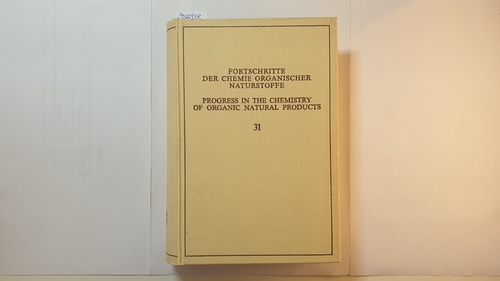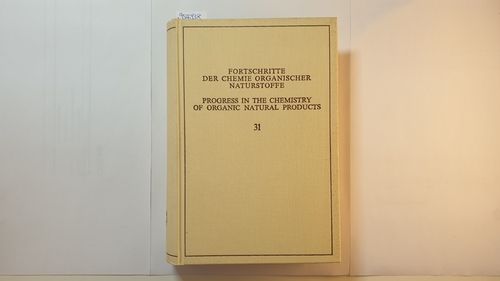
Fortschritte der Chemie organischer Naturstoffe Teil: Vol. 31.(Progress in the Chemistry of Organic Natural Products) - gebunden oder broschiert
1974, ISBN: 3211811729
[EAN: 9783211811726], Gebraucht, sehr guter Zustand, [PU: Springer, Wien ; New York, NY], ROHSTOFFE / MATERIE ENERGIE ELEKTROSMOG MATERIAL NATURWISSENSCHAFTEN WISSENSCHAFT REVOLUTIONEN, 2… Mehr…
| AbeBooks.de Gebrauchtbücherlogistik H.J. Lauterbach, Gummersbach, NRW, Germany [1047495] [Rating: 5 (von 5)] NOT NEW BOOK. Versandkosten: EUR 3.15 Details... |

Fortschritte der Chemie organischer Naturstoffe Teil: Vol. 31.(Progress in the Chemistry of Organic Natural Products) - gebunden oder broschiert
1974, ISBN: 3211811729
[EAN: 9783211811726], Gebraucht, sehr guter Zustand, [PU: Springer, Wien ; New York, NY], ROHSTOFFE / MATERIE ENERGIE ELEKTROSMOG MATERIAL NATURWISSENSCHAFTEN WISSENSCHAFT REVOLUTIONEN, 2… Mehr…
| AbeBooks.de Gebrauchtbücherlogistik H.J. Lauterbach, Gummersbach, NRW, Germany [1047495] [Rating: 5 (von 5)] NOT NEW BOOK. Versandkosten: EUR 3.15 Details... |

Fortschritte der Chemie Organischer Naturstoffe / Progress in the Chemistry of Organic Natural Products: v.31 - gebunden oder broschiert
1974, ISBN: 9783211811726
Springer, Hardcover, 696 Seiten, Publiziert: 1974-07-26T00:00:01Z, Produktgruppe: Book, 1.52 kg, Pharmacy - Dispensing, Ancillary Services, Medical & Healthcare Practitioners, Health, Fam… Mehr…
| amazon.co.uk SerendipityBooksLtd Versandkosten:Usually dispatched within 3 to 4 days. Die angegebenen Versandkosten können von den tatsächlichen Kosten abweichen. (EUR 5.77) Details... |

Fortschritte der Chemie organischer Naturstoffe Teil: Vol. 31.(Progress in the Chemistry of Organic Natural Products) - gebrauchtes Buch
1974, ISBN: 9783211811726
23,5 cm. IX, 693 S. : graph. Darst. Gewebe (Heller Braun) Zustand: Sehr Gut, eher ungelesen (Innen); Schnitt oben gering angestaubt, Seitlicher Schnitt ist min. braunfleckig; Einband (Auß… Mehr…
| buchfreund.de Gebrauchtbücherlogistik, 51647 Gummersbach Versandkosten:Versandkosten innerhalb der BRD. (EUR 5.40) Details... |

Fortschritte der Chemie organischer Naturstoffe Teil: Vol. 31.(Progress in the Chemistry of Organic Natural Products) - gebrauchtes Buch
ISBN: 3211811729
23,5 cm. IX, 693 S. : graph. Darst. Gewebe (Heller Braun), [PU: Springer, Wien]
| Antikbuch24.de |


Fortschritte der Chemie organischer Naturstoffe Teil: Vol. 31.(Progress in the Chemistry of Organic Natural Products) - gebunden oder broschiert
1974, ISBN: 3211811729
[EAN: 9783211811726], Gebraucht, sehr guter Zustand, [PU: Springer, Wien ; New York, NY], ROHSTOFFE / MATERIE ENERGIE ELEKTROSMOG MATERIAL NATURWISSENSCHAFTEN WISSENSCHAFT REVOLUTIONEN, 2… Mehr…

Diverse:
Fortschritte der Chemie organischer Naturstoffe Teil: Vol. 31.(Progress in the Chemistry of Organic Natural Products) - gebunden oder broschiert1974, ISBN: 3211811729
[EAN: 9783211811726], Gebraucht, sehr guter Zustand, [PU: Springer, Wien ; New York, NY], ROHSTOFFE / MATERIE ENERGIE ELEKTROSMOG MATERIAL NATURWISSENSCHAFTEN WISSENSCHAFT REVOLUTIONEN, 2… Mehr…

Fortschritte der Chemie Organischer Naturstoffe / Progress in the Chemistry of Organic Natural Products: v.31 - gebunden oder broschiert
1974
ISBN: 9783211811726
Springer, Hardcover, 696 Seiten, Publiziert: 1974-07-26T00:00:01Z, Produktgruppe: Book, 1.52 kg, Pharmacy - Dispensing, Ancillary Services, Medical & Healthcare Practitioners, Health, Fam… Mehr…

Fortschritte der Chemie organischer Naturstoffe Teil: Vol. 31.(Progress in the Chemistry of Organic Natural Products) - gebrauchtes Buch
1974, ISBN: 9783211811726
23,5 cm. IX, 693 S. : graph. Darst. Gewebe (Heller Braun) Zustand: Sehr Gut, eher ungelesen (Innen); Schnitt oben gering angestaubt, Seitlicher Schnitt ist min. braunfleckig; Einband (Auß… Mehr…
Bibliographische Daten des bestpassenden Buches
Detailangaben zum Buch - Fortschritte der Chemie Organischer Naturstoffe / Progress in the Chemistry of Organic Natural Products: v.31
EAN (ISBN-13): 9783211811726
ISBN (ISBN-10): 3211811729
Gebundene Ausgabe
Erscheinungsjahr: 1974
Herausgeber: Springer
Buch in der Datenbank seit 2008-05-05T11:35:58+02:00 (Berlin)
Detailseite zuletzt geändert am 2024-01-11T08:21:58+01:00 (Berlin)
ISBN/EAN: 9783211811726
ISBN - alternative Schreibweisen:
3-211-81172-9, 978-3-211-81172-6
Alternative Schreibweisen und verwandte Suchbegriffe:
Autor des Buches: zechmeister, mcgregor, schmidt, schrauzer, harris, wagner, andersen, winterfeldt
Titel des Buches: fortschritte der chemie organischer naturstoffe, progress the chemistry organic natural products, fortschritt
Daten vom Verlag:
Autor/in: N. H. Andersen; St. F. Brady; C. M. Harris; Th. M. Harris; E. Hecker; K. B. Hindley; D. N. McGregor; J. A. Marshall; J. C. Roberts; R. Schmidt; G. N. Schrauzer; G. A. Swan; Ch. Tamm; H. Wagner; E. Winterfeldt
Titel: Fortschritte der Chemie organischer Naturstoffe Progress in the Chemistry of Organic Natural Products; Fortschritte der Chemie Organischer Naturstoffe / Progress in the Chemistry of Organic Natural Products
Verlag: Springer; Springer Wien
696 Seiten
Erscheinungsjahr: 1974-07-26
Vienna; AT
Gewicht: 1,520 kg
Sprache: Englisch
85,55 € (DE)
87,95 € (AT)
106,60 CHF (CH)
Not available, publisher indicates OP
BB; Book; Hardcover, Softcover / Chemie/Organische Chemie; Organische Chemie; Verstehen; natural product; chemistry; B; Organic Chemistry; Chemistry and Materials Science; Biochemistry, general; Pharmacology/Toxicology; Plant Sciences; Pharmacy; Biochemie; Pharmakologie; Botanik und Pflanzenwissenschaften; Pharmazie, Apotheke; BC; EA
/ Contents.- Recent Developments in the Chemistry of Penicillins.- I. Introduction.- II. Nomenclature.- III. Reactions at the ?-Lactam Ring.- A. Acylation of the 6-Amino Group.- B. Alkylation of the 6-Amino Group.- C. Hydrolysis of the 6-Amido Group.- D. Epimerization at the 6-Position.- E. Diazotization of the 6-Amino Group.- F. Substitution at the 6-Position.- G. Cleavage of the C-7-N-4 Bond.- IV. Reactions at the Thiazolidine Ring.- A. Rearrangements of Penicillin Sulfoxides.- B. Other Thiazolidine Ring Cleavages.- C. Miscellaneous Nuclear Transformations.- D. Modification of the 3-Carboxylic Acid.- V. Conclusion.- References.- The Antibiotic Complex of the Verrucarins and Roridins.- I. Introduction.- II. Production and Isolation.- III. Structure and Chemical Transformations.- 1. Sterols.- 2. Chromane Derivatives.- 2.1. Myrochromanol and Myrochromanone.- 3. Pyrrole Derivatives.- 3.1. Verrucarin E.- 3.2. Verrucarin G.- 4. Macrocyclic Trichothecane Esters.- 4.1. Verrucarol and Roridin C (Trichodermol).- 4.2. Verrucarin A and 2?-Dehydroverrucarin A.- 4.3. Verrucarin B.- 4.4. Verrucarin J.- 4.5. Roridin A.- 4.6. Roridin D.- 4.7. Roridin E.- 4.8. Roridin H.- 5. Wortmannin.- IV. Total Synthesis.- V. Methods of Assay.- VI. Biosynthesis.- 1. Pyrrole Derivatives.- 2. Trichothecane Esters.- VII. Biological Activity.- 1. Antibiotic Activity.- 2. Cytostatic Activity.- 3. Toxicity.- 4. Structure and Biological Activity.- Acknowledgement.- References.- Aflatoxins and Sterigmatocystins.- I. Introduction.- II. Isolation and Characterisation of the Mycotoxins.- III. Structural Elucidation of the Mycotoxins.- 1. Sterigmatocystin.- 2. Other Metabolites Closely Related to Sterigmatocystin.- 3. Aspertoxin.- 4. Aflatoxin-B1, -B2, -Gl, and -G2.- 5. Aflatoxin-M1 and -M2.- 6. Aflatoxin-B2a and -G2a.- IV. Synthesis of the (±)-Forms of the Mycotoxins and of Related Compounds.- 1. Tetrahydro-4-hydroxy-6-methoxyfuro[2,3-b]benzofuran.- 2. Tetrahydrodeoxoaflatoxin-B1.- 3. Aflatoxin-B1.- 4. Aflatoxin-B2.- 5. Aflatoxin-G1.- 6. Aflatoxin-M1.- 7. Dihydro-O-methylsterigmatocystin.- 8. O-methylsterigmatocystin.- V. Biogenesis of the Mycotoxins.- 1. Sterigmatocystin.- 2. Aflatoxin-B1.- VI. Conclusion.- References.- Flavonoid-Glykoside.- I. Strukturtypen von Flavonoid-O-Glykosiden und ihre Verbreitung.- 1. Glykosidierungsmuster.- 2. O-Monoside.- 3. O-Bioside.- 4. O-Trioside, Tri-, Tetra- und Poly-O-Glykoside.- 5.O-Glykuronide.- 6. Acyl-O-Glykoside.- II. Flavonoid-C-Glykoside.- III. Synthese von Flavonoidglykosiden.- 1. Darstellung von Acetobromzuckern.- 2. Synthese von O-Monosiden und O-Biosiden.- a) Glykosidierung der C7-OH-Gruppe.- b) Glykosidierung der C3-OH-Gruppe.- c) Glykosidierung der C4?-C2?-C3?-C5-OH-Gruppen.- 3. Synthese von Flavonoid-O-Bisglykosiden.- 4. Synthese von Flavonoid-C-Glykosiden.- Addenda.- Biogenetic-Type Syntheses of Polyketide Metabolites.- I. Introduction.- II. Early Studies.- III. Modern Concepts of Polyketide Biosynthesis.- IV. Experimental Support for the Polyketide Theory.- V. Syntheses of ?-Polycarbonyl Compounds.- 1. 3,5-Diketo Acids and Esters.- 2. 1,3,5-Triketones.- 3. 3,5,7-Triketo Acids and Esters.- 4. 1,3,5,7-Tetraketones.- 5. 3,5,7,9-Tetraketo Acids and Esters.- 6. 1,3,5,7,9-Pentaketones.- 7. 3,5,7,9,11-Pentaketo Acids and Esters.- 8. 1,3,5,7,9,11-Hexaketones.- 9. ?-Heptacarbonyl Compounds.- 10. ?-Octacarbonyl Compounds.- 11. ?-Nonacarbonyl Compounds.- 12. Reduced Polycarbonyl Compounds.- VI. Cyclizations of ?-Polycarbonyl Compounds.- 1. Using Several Ketide Fragments.- 2. Using a Single Polycarbonyl Compound.- a) With 3,5-Diketo Acids.- b) With 1,3,5-Triketones.- c) With 3,5,7-Triketo Acids and Esters.- d) With 1,3,5,7-Tetraketones.- e) With 3,5,7,9-Tetraketo Acids and Esters.- f) With 1,3,5,7,9-Pentaketones.- g) With ?-Hexacarbonyl Compounds.- h) With ?-Heptacarbonyl Compounds.- i) With ?-Octacarbonyl Compounds.- j) With ?-Nonacarbonyl Compounds.- k) With Reduced ?-Polycarbonyl Compounds.- 3. Using Partially Cyclized Polycarbonyl Compounds.- VII. Conclusions.- References.- The Chemistry of Spiro[4.5]Decane Sesquiterpenes.- A. Introduction.- B. The Acoranes and Alaskanes.- 1. Structure Elucidation of the Acorus Spiranes.- 2. The Alaskanes, Precursors of Cedrene.- 3. Mass Spectral Considerations.- 4. Synthesis.- C. The Spirovetivanes.- 1. Structure.- a) Agarospirol.- b) ?-Vetivone and Related Compounds.- 2. Synthesis.- D. Biogenetic Considerations.- 1. The Relationship between Spirovetivanes and Hydronaphthalenic Sesquiterpenes.- 2. Alaskane-Acorane Spiranes as Precursors of Tricyclic Sesquiterpenes.- 3. Chemical Simulation of Biogenetic Pathways involving Spiro[4.5]Decanes.- E. Tables of Naturally Occurring Spiro[4.5]Decanes.- Addendum.- References.- Phorbolesters — the Irritants and Cocarcinogens of Croton Tiglium L..- 1. Introduction.- 2. Fractionation of Croton Oil.- 2.1. General Analytical Chemical Procedures and Biological Assays.- 2.1.1. Methods of Separation and Criteria of Purity.- 2.1.2. Monitoring of Fractionation Steps.- 2.2. Preparation of the Hydrophilic and the Hydrophobic Portions.- 2.3. Phorbol Diesters from the Hydrophilic Portion.- 2.3.1. Isolation and Resolution of Croton Oil Factor Groups A and B.- 2.3.2. Chemical Characterization of the Croton Oil Factors from Groups A and B as Diesters of Phorbol.- 2.4. Higher Phorbol Esters from the Hydrophobic Portion.- 2.4.1. Isolation and Resolution of Croton Oil Factor Groups A’ and B’.- 2.4.2. Separation and Chemical Characterization of the Croton Oil Factors from Groups A’ and B’.- 3. Chemistry of Phorbol and of the Croton Oil Factors.- 3.1. Structure and Stereochemistry of Phorbol.- 3.2. Reactions Altering the Functional Groups of Phorbol.- 3.2.1. Functional Derivatives of the Carbonyl Group.- Reaction with Carbonyl Reagents.- Reduction of the Carbonyl Group.- 3.2.2. Functional Derivatives of the Hydroxyl Groups.- Phorbol Esters.- Phorbol Ethers.- Oxidation of Single Hydroxyl Groups.- Substitution and Elimination of Hydroxyl Groups.- 3.2.3. Functional Derivatives Involving the C = C-Bonds.- Catalytic Hydrogenation.- Bromination and Hydrobromination.- Oxidation.- 3.3. Structure of the Croton Oil Factors.- 3.3.1. Phorbol Diesters from the Hydrophilic Portion.- 3.3.2. Phorbol Triesters from the Hydrophobic Portion.- 3.4. Reactions Altering the Tigliane Skeleton of Phorbol and of Neophorbol.- 3.4.1. Dehydrogenation of Phorbol and 3-Deoxo-3?-hydroxyphorbol.- 3.4.2. Oxidative Ring Opening of Phorbol and Derivatives.- Ring A.- Ring B.- Rings C and D (Bicyclo[4.1.0]heptane System).- 3.4.3. Rearrangements in Phorbol and Neophorbol involving the Bicyclo[4.1.0]-heptane System.- Crotophorbolone-enol-13,20-diacetate and Acetoxycrotophorbolone-20-acetate.- Phorbobutanone and Phorboisobutanone.- The “Flaschenträger Reaction”.- 12,13-Ketol Rearrangement in Neophorbol.- 4. Further Diterpenes and Diterpene Esters from Croton Oil.- 4.1. Chemistry of 4?-Phorbol.- 4.2. Chemistry of 4-Deoxy-4?-phorbol and 4-Deoxyphorbol.- 4.3. Compound Groups D, E, D’ and E’ from Croton Oil.- 4.4. Composition of Croton Oil with Regard to Diterpenes and their Esters.- 5. On the Biological Activities of the Isolated Diterpenes and their Esters.- 6. Conclusions and Perspectives.- References.- Stereoselektive Totalsynthese von Indolalkaloiden..- Structure, Chemistry, and Biosynthesis of the Melanins..- I. Introduction.- II. Enzymic Nature of Melanogenesis.- 1. Melanogenesis in Invertebrates and Plants.- 2. Melanogenesis in Vertebrates.- 3. The Enzyme.- III. Allomelanins.- 1. Catechol-Melanin.- 2. Natural Allomelanins.- IV. Eumelanins.- 1. Chemical Investigations on Dopa-Melanin and 5,6-Dihydroxyindole-Melanin.- 1.1. Introduction.- 1.2. Studies on Model Compounds.- 1.3. Isotopic and Degradative Studies.- 1.4. Conclusion Regarding the Structure of Melanin.- 1.5. Studies Relevant to the Structure of the Melanoproteins.- 2. Chemical and Biochemical Investigations on Natural Eumelanins.- 2.1. Introduction.- 2.2. Sepiomelanin.- 2.3. Melanin from Melanoma.- 2.4. Melanin from Hair.- 2.5. Melanin from the Eye.- 2.6. Other Melanins.- 3. Investigations on Melanins by Spectroscopic and other Physical Methods.- 3.1. Ultraviolet and Infrared Spectra.- 3.2. X-Ray Diffraction.- 3.3. Electron Spin Resonance.- 4. Adrenochrome-Melanin.- 5. Dopamine-Melanin.- V. Phaeomelanins.- VI. Conclusions.- References.- Addendum.- Mechanisms of Corrin Dependent Enzymatic Reactions..- I. Introduction.- II. Nomenclature.- III. Properties and Reactions of Corrins and Related Compounds.- 1. Vitamin B12 Chemistry.- 2. Vitamin B12 Model Compounds.- 3. Coenzyme B12 Reactions.- IV. Coenzyme B12 Dependent Enzymatic Reactions.- 1. Dioldehydrases.- 2. Ethanolamine Deaminase.- 3. Ribonucleotide Reductase.- 4. Mutases.- 5. Aminomutases.- V. Corrin Dependent Enzymatic Reactions.- 1. Methane Biosynthesis.- 2. Acetate Biosynthesis.- 3. Methylarsine Biosynthesis.- 4. Methylmercury Formation.- 5. Methionine Biosynthesis.- References.- Namenverzeichnis. Author Index.- Sachverzeichnis. Subject Index.Weitere, andere Bücher, die diesem Buch sehr ähnlich sein könnten:
Neuestes ähnliches Buch:
9780130531742 Conversation Book: English in Everyday Life, Book 1 (Carver, Tina Kasloff, Fotinos, Sandra Douglas)
- 9780130531742 Conversation Book: English in Everyday Life, Book 1 (Carver, Tina Kasloff, Fotinos, Sandra Douglas)
- 9780131723702 Conversation Book: English in Everyday Life, Book II (Carver, Tina Kasloff, Fotinos, Sandra Douglas)
- 9780136138112 Leukocyte Adhesion Molecules: Proceedings of the First International Conference on: "Structure, Function and Regulation of Molecules Involved in ... West Germany, September 28 - October 2, 1988 (Timothy A. Springer, Donald C. Anderson, Alan S. Rosenthal, Robert Rothlein)
- Fortschritte der Chemie organischer Naturstoffe / Progress in the Chemistry of Organic Natural Products (Volume 60) (2013-10-04) (unknown)
< zum Archiv...



